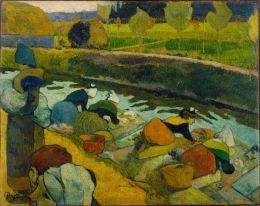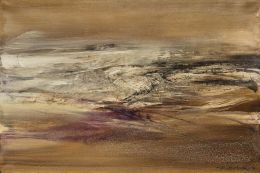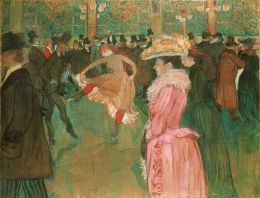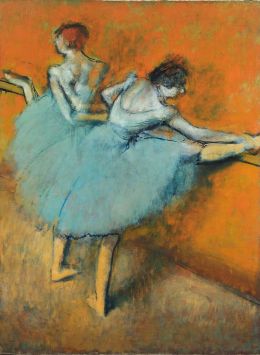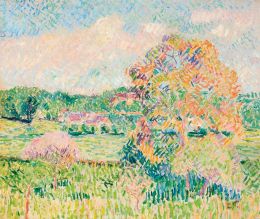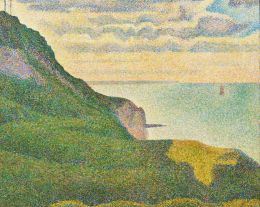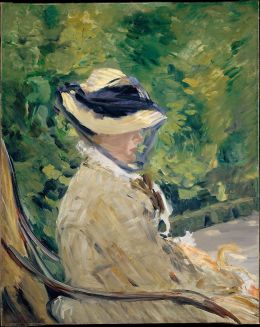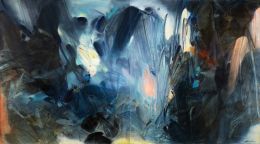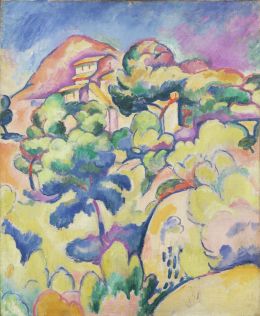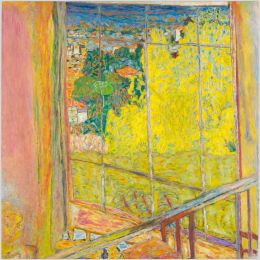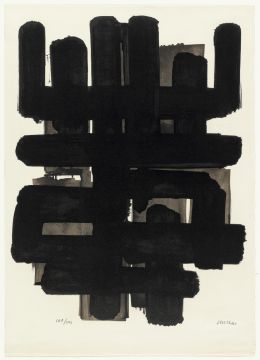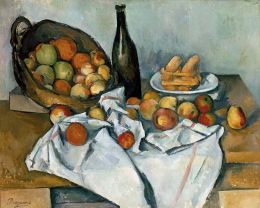- 1848 - 1903French
Eugène Henri Paul Gauguin ( 7 June 1848 – 8 May 1903) was a French Post-Impressionist artist. Unappreciated until after his death, Gauguin is now recognized for his experimental use of color and Synthetist style that were distinct from Impressionism. Toward the end of his life, he spent ten years in French Polynesia. The paintings from this time depict people or landscapes from that region.
His work was influential on the French avant-garde and many modern artists, such as Pablo Picasso and Henri Matisse, and he is well known for his relationship with Vincent and Theo van Gogh.… more
- 1921 - 2013Chinese, French
Known for his proficiency with both Eastern and Western artistic traditions, and his ability to employ both simultaneously within his work, Zao Wou-Ki has become an important figure in mid-century art historical canon. Born Zhao Wou-Ki (assuming the name Zao after 1947) in 1920 in Peking (now Beijing), Wou-Ki attending the National School of Arts, Hangchow, for six years before becoming a drawing instructor there. In 1947, the artist moved to Paris where he would become friends with the artists Alberto Giacometti and Joan Miró. His work, done in an abstract, gestural style quickly drew… more
- 1864 - 1901French
An aristocratic, alcoholic dwarf known for his louche lifestyle, Henri de Toulouse-Lautrec created art that was inseparable from his legendary life. His career lasted just over a decade and coincided with two major developments in late nineteenth-century Paris: the birth of modern printmaking and the explosion of nightlife culture. Lautrec’s posters promoted Montmartre entertainers as celebrities, and elevated the popular medium of the advertising lithograph to the realm of high art. His paintings of dance hall performers and prostitutes are personal and humanistic, revealing the sadness… more
- 1834 - 1917French
Edgar Degas ( 19 July 1834 – 27 September 1917) was a French Impressionist artist famous for his pastel drawings and oil paintings.
Degas also produced bronze sculptures, prints and drawings. Degas is especially identified with the subject of dance; more than half of his works depict dancers. Although Degas is regarded as one of the founders of Impressionism, he rejected the term, preferring to be called a realist, and did not paint outdoors as many Impressionists did.
Degas was a superb draftsman, and particularly masterly in depicting movement, as can be seen in his… more
- 1869 - 1954French
Henri Émile Benoît Matisse ( 31 December 1869 – 3 November 1954) was a French visual artist, known for both his use of colour and his fluid and original draughtsmanship. He was a draughtsman, printmaker, and sculptor, but is known primarily as a painter.[1] Matisse is commonly regarded, along with Pablo Picasso, as one of the artists who best helped to define the revolutionary developments in the visual arts throughout the opening decades of the twentieth century, responsible for significant developments in painting and sculpture.
The intense colourism of the works he painted… more
- 1830 - 1903French
Camille Pissarro ( 10 July 1830 – 13 November 1903) was a Danish-French Impressionist and Neo-Impressionist painter born on the island of St Thomas (now in the US Virgin Islands, but then in the Danish West Indies). His importance resides in his contributions to both Impressionism and Post-Impressionism. Pissarro studied from great forerunners, including Gustave Courbet and Jean-Baptiste-Camille Corot. He later studied and worked alongside Georges Seurat and Paul Signac when he took on the Neo-Impressionist style at the age of 54.
In 1873 he helped… more
- 1840 - 1926French
Oscar-Claude Monet ( 14 November 1840 – 5 December 1926) was a French painter and founder of impressionist painting who is seen as a key precursor to modernism, especially in his attempts to paint nature as he perceived it. During his long career, he was the most consistent and prolific practitioner of impressionism's philosophy of expressing one's perceptions before nature, especially as applied to plein air (outdoor) landscape painting. The term "Impressionism" is derived from the title of his painting Impression, soleil levant, exhibited in the 1874 ("exhibition of rejects") initiated… more
- 1859 - 1891French
Neo-Impressionism is a term applied to an avant-garde art movement that flourished principally in France from 1886 to 1906. Led by the example of Georges Seurat, artists of the Neo-Impressionist circle renounced the random spontaneity of Impressionism in favor of a measured painting technique grounded in science and the study of optics. Encouraged by contemporary writing on color theory—the treatises of Charles Henry, Eugène Chevreul, and Odgen Rood for example—Neo-Impressionists came to believe that separate touches of interwoven pigment result in a greater vibrancy of color in the… more
- 1832 - 1883French
Édouard Manet ( 23 January 1832 – 30 April 1883) was a French modernist painter. He was one of the first 19th-century artists to paint modern life, as well as a pivotal figure in the transition from Realism to Impressionism.
Born into an upper-class household with strong political connections, Manet rejected the naval career originally envisioned for him; he became engrossed in the world of painting. His early masterworks, The Luncheon on the Grass (Le déjeuner sur l'herbe) and Olympia, both 1863, caused great controversy and served as rallying points for the young painters who… more
- 1920 -2014Chinese, French
Chu Teh-Chun or Zhu Dequn (24 October 1920 – 26 March 2014) was a Chinese-French abstract painter acclaimed for his pioneering style integrating traditional Chinese painting techniques with Western abstract art. Chu Teh-Chun enrolled in the National School of Fine Arts (now China Academy of Art), where he studied under Fang Ganmin and Wu Dayu. He was the first ethnic Chinese member of the Académie des Beaux-Arts of France, and together with Wu Guanzhong and Zao Wou-Ki… more
- 1841 - 1919French
Renoir was one of the leading painters of the Impressionist group. He evolved a technique of broken brushstrokes and used bold combinations of pure complementary colours, to capture the light and movement of his landscapes and figure subjects. Following a visit to Italy in 1881 his style changed, becoming more linear and classical.
Renoir was born in Limoges in south-west France, where he began work as a painter on porcelain. He moved to Paris, joining the studio of the fashionable painter Charles Gleyre in around 1861-2. Courbet influenced the young Renoir. In Paris he encountered… more
- 1882 - 1963French
Georges Braque ( 13 May 1882 – 31 August 1963) was a major 20th-century French painter, collagist, draughtsman, printmaker and sculptor. His most notable contributions were in his alliance with Fauvism from 1905, and the role he played in the development of Cubism. Braque's work between 1908 and 1912 is closely associated with that of his colleague Pablo Picasso. Their respective Cubist works were indistinguishable for many years, yet the quiet nature of Braque was partially eclipsed by the fame and notoriety of … more
- 1867 - 1947French
Pierre Bonnard (French; 3 October 1867 – 23 January 1947) was a French painter, illustrator and printmaker, known especially for the stylized decorative qualities of his paintings and his bold use of color. A founding member of the Post-Impressionist group of avant-garde painters Les Nabis, his early work was strongly influenced by the work of Paul Gauguin, as well as the prints of Hokusai and other Japanese artists. Bonnard was a leading figure in the transition from Impressionism to… more
- 1919French
Pierre Soulages was born on December 24, 1919, in Rodez, in the south of France. As a child, he was fascinated by the Celtic carvings in the local museum and the architecture of the abbey of Sainte-Foy in nearby Conques, and these early impressions would continue to surface throughout his career. In 1938, inspired by the works of Paul Cézanne and Pablo Picasso, he enrolled in the École nationale supérieure des beaux-arts, Paris, but he was disappointed by the traditional instruction and soon moved back to Rodez.
In 1946, having served in the military during World War II, Soulages… more
- 1839 - 1906French
Paul Cézanne ( 19 January 1839 – 22 October 1906) was a French artist and Post-Impressionist painter whose work laid the foundations of the transition from the 19th-century conception of artistic endeavour to a new and radically different world of art in the 20th century.
Cézanne is said to have formed the bridge between late 19th-century Impressionism and the early 20th century's new line of artistic enquiry, Cubism. Cézanne's often repetitive, exploratory brushstrokes are highly characteristic and clearly recognizable. He used planes of colour and small brushstrokes that build up… more
